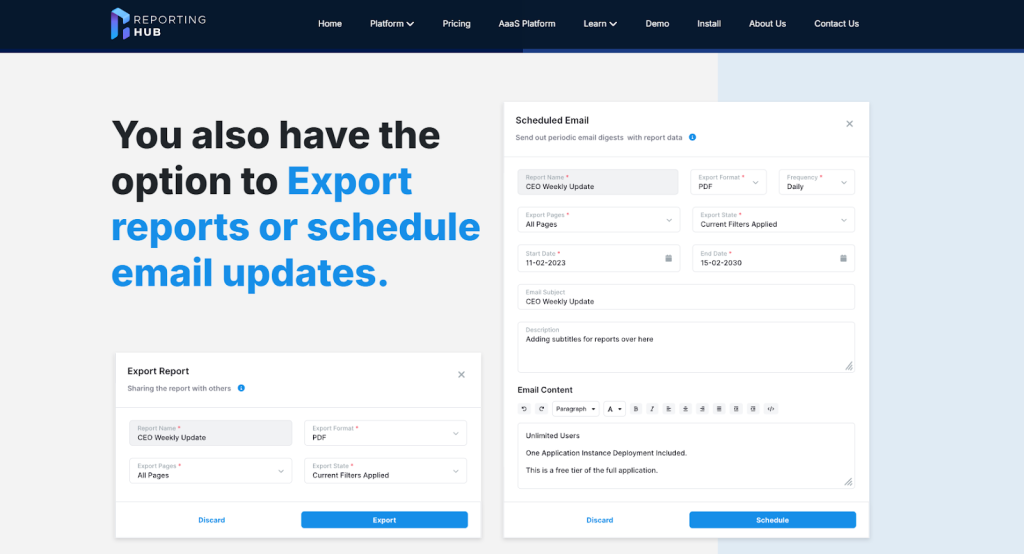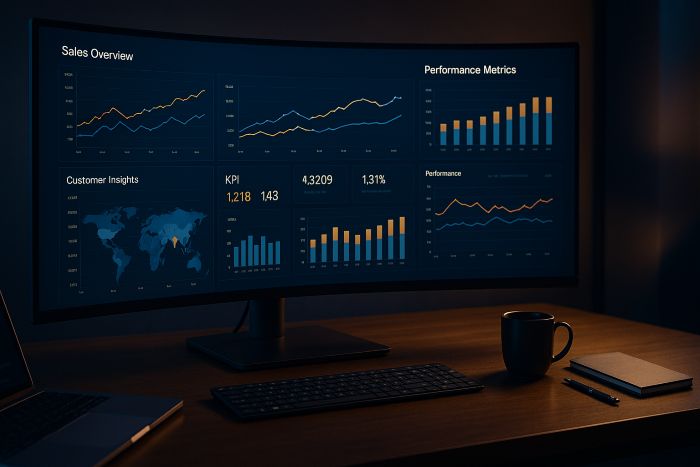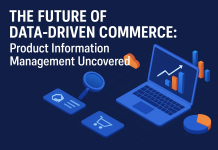Data sharing is the bridge between your analysis and real decisions across the organization. Teams move faster when the right people can open the right view at the right time. With smart choices, it becomes easy to share Power Bi dashboard views for leaders and to share power bi report pages for editors and clients. Reporting Hub provides a friendly home where people actually return to explore insights while you keep branding, access, and governance under control.
Key Takeaways
- Data sharing enhances decision-making by enabling timely access to insights.
- The best ways to share Power BI reports include using the sharing tool, publishing to workspaces, and embedding in Teams.
- Reporting Hub centralizes report sharing, improving engagement and reducing redundant reports.
- Plan for licensing, roles, and permissions to ensure smooth report sharing and access control.
- Scheduled exports and branded portals keep non-Power BI users engaged and informed over time.
Table of contents
How to Share a Report in Power BI: 6 Best Ways
The best method depends on the audience, frequency, and control. Pick the mix that helps you share Power BI dashboard content widely while maintaining a smooth workflow for every stakeholder. Here are the best six ways:
- Use the Power BI Report and Dashboard Sharing Tool
- Publish Reports to a Power BI Workspace
- Embed Power BI Reports in Microsoft Teams
- Share Power BI Reports via Apps
- Publish to the Web
- Share Reports Externally with Secure Access
1. Use the Power BI Report and Dashboard Sharing Tool
This category delivers a clean viewing experience above the analytics platform. It gives nontechnical audiences one place to open insights, download snapshots, and come back for fresh updates, making it simple to share Power BI report content without extra steps.
Businesses that centralize report delivery in branded hubs see a 28% faster adoption rate among non-technical users than those that use email-based sharing, per Gartner’s 2025 Analytics Platform Review.
1. Reporting Hub

Reporting Hub is the best power BI report sharing tool, that centralizes your content and allows you to distribute reports in the simplest ways possible. You can embed interactive reports, schedule email or file exports, and add helpful links so everything lives in one familiar place. The setup supports enterprise sign-in, multi-tenant audiences, and Row-Level Security, which keeps each viewer focused on what is meant for them.
In practice, you share Power BI dashboard views confidently, automate routine updates, and make it simple to share the reports that busy executives will actually open. According to Microsoft’s 2024 Fabric documentation, companies that use centralized reporting portals can cut down on the creation of duplicate reports by up to 35%, which enhances departmental governance and performance monitoring.
Why It Stands Out
- Branded and secure delivery
- Multi-tenant and role-based access
- Embeds and scheduled exports
- Flexible enterprise sign-in options
2. Binokula
Binokula packages analytics for client viewing with simple external access. It covers the basics for smaller rollouts, although branding depth and automation can feel lighter when you plan to share Power BI dashboard content across many separate client groups.
3. Webdashboard
Webdashboard offers straightforward viewing for audiences that need quick checks. It is useful for simple scenarios, yet larger programs may want more granular control and automation when they share Power BI report content at scale and across varied permission models.
2. Publish Reports to a Power BI Workspace
Workspace sharing is a dependable route when your audience already works inside Microsoft 365. You add people to a workspace, set roles, and collaborate on models and visuals. This remains a reliable way to share Power BI dashboard tiles and share power bi report pages with analysts and contributors who build content.
Pros
- Strong governance through workspace roles
- Smooth collaboration for creators and editors
Cons
- External delivery requires extra configuration
- License requirements can limit the reach of viewers
3. Embed Power BI Reports in Microsoft Teams
Teams share and meet people inside everyday conversations. You pin a report as a tab in a Team or channel and keep insights next to chat. This helps you share Power BI dashboard summaries during standups and quick decision threads without switching tools.
According to Microsoft’s 2025 Work Trend Index, adding Power BI to Teams increases report engagement by 37%. It also lowers context-switching time by almost 20% for teams focused on analytics.
Pros
- Access inside the daily workflow
- Real-time discussion beside the data
Cons
- Still tied to roles and licenses
- Too many tabs can dilute focus
4. Share Power BI Reports Via Apps
Apps bundle curated dashboards and reports into a clean package that you publish to groups. Stakeholders always know where to click, which reduces hunting. This keeps your share Power BI report collections organized for large audiences that mainly consume rather than build, and it also supports repeatable ways to present content for leadership. According to the 2025 Gartner Analytics Platform Capabilities Report, organizations that use Power BI Apps for centralized delivery see a 32% improvement in finding reports. They also experience a 27% decrease in unnecessary dashboard publishing.
Pros
- Clean, versioned delivery at scale
- Easy discovery for broad audiences
Cons
- Updates require a publish step
- Less flexible for quick one-off shares
5. Publish to the Web
Public publishing is right for content that is safe for everyone to see. It is ideal for education, marketing, or community storytelling. It is not for private or regulated data. For anything sensitive, rely on secure methods to share Power BI dashboard content with identity controls in place. As of Microsoft’s 2025 Power BI Security Update, “Publish to Web” links now have expiration controls and optional viewer authentication for certain tenant settings. This change lowers the risk of long-term unauthorized access.
Pros
- Instant reach without sign-in
- Simple to embed on sites and blogs
Cons
- Public exposure of the content
- Limited control over viewers
6. Share Reports Externally with Secure Access
External sharing provides professional delivery of clients as well as safekeeping of confidential information. You have to establish a guest access or rely on a delivery layer that deals with identity, permissions, and Row-Level Security. Done well, this path lets you share Power BI report pages with each client group without complex onboarding and keeps presentations consistent when you also share Power BI dashboard views.
Pros
- Client-friendly and secure experience
- Works well with role-based control
Cons
- Initial configuration requires planning
- Mixed license models add complexity

Key Things to Know Before Sharing a Power BI Report
A few early choices save hours later, such as clear licensing, defined roles, and precise permissions, making it easier to share a Power BI report on schedule and avoid last-minute access surprises when leadership needs answers.
Licenses
Creators often use Pro or Premium Per User. Premium capacity broadens access for larger audiences and can reduce friction for consumer-only viewers. Match the plan to how frequently you publish and how widely you distribute content across departments.
Roles
Clear roles make collaboration predictable. Define Admin, Member, Contributor, and Viewer before the first release so editing is controlled and viewing is simple. This keeps authors focused on building, while consumers have a consistent path to explore and to share Power BI dashboard snapshots with their teams.
Permissions
Groups are easier to maintain than individual assignments. Combine workspace roles with Row-Level Security to keep every audience focused on the right slice. This structure prevents accidental oversharing as programs grow and projects multiply.
How to Share Power BI Dashboard and Report with Reporting Hub
Reporting Hub offers a straightforward routine that scales from an internal team to many client accounts. The experience is branded, the navigation is tidy, and the access model fits enterprise identity. This gives you a predictable home where people come back to explore and where you confidently share Power BI dashboard collections without extra training.
- Embed your Power BI content: Add interactive dashboards, reports, or paginated views to your portal and organize them by audience. People return to the same place to explore, compare, and act, which encourages repeat visits and makes adoption stick.
- Schedule email or file exports: Automate PDF or Excel delivery on a cadence so executives receive fresh snapshots even if they do not log in often. This habit keeps attention high and reduces ad hoc requests while you share Power BI report updates with consistency.
- Link helpful resources: Bring training, documentation, or external tools into the same portal so users have context and analytics in one place. This reduces back and forth and strengthens adoption because everything needed to make a decision sits together.
Final Words
A reliable sharing routine turns analytics into everyday action. Workspaces help builders collaborate. Teams and Apps anchor conversations in live metrics. When scale and presentation matter, Reporting Hub gives you a polished home for insights. Use it to automate updates, centralize navigation, and maintain control while you share Power BI dashboard experiences that people actually open. The same structure keeps executive communication consistent when you schedule snapshots and publish curated spaces.
Frequently Asked Questions
What Is the Quickest Way to Send Reports to Executives?
Scheduled exports are the fastest path. Executives receive a PDF or Excel snapshot on time, and your team keeps a simple, dependable cadence without manual work.
How Should I Approach External Client Access?
Role-based access with Row-Level Security keeps each client focused on their own data. A branded portal reduces confusion and supports professional delivery.
When Should I Choose an App Instead of Direct Sharing?
Apps are ideal for curated, read-only consumption at scale. Direct workspace access is better for builders who co-author and frequently iterate together.
Is Publishing to the Web Ever Right for Internal Data?
Public links are for open education or marketing. Private or regulated data belongs on secure options with authentication and governance in place.
What Keeps Non-Power BI Users Engaged Over Time?
Scheduled emails plus a familiar portal create a dependable habit loop. People receive snapshots on time and know exactly where to return to explore more.











